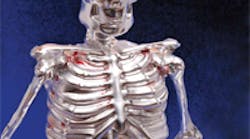One of the developments debuted at IMTS 2008 was the creation of a miniature-scale, human skeleton that was being machined from a 6 in. by 12-in. aluminum billet.
“Bones” was being made on an AgieCharmilles Mikron UCP 600 Vario machining center that used a variety of high speed tools for aluminum from Seco Tools, including the company’s new Jabro solid-carbide endmill.
The intricate machining demonstration was being used to illustrate the tools Seco (www.secotools.com) offers for machining of orthopedic components and other microapplications.
To produce the aluminum skeleton, Seco joined with Capture 3D (www.capture3d.com).
That company’s white light scanning software was used to produce an STL model of the skeleton from a life-sized model. The STL model then was converted into a solid model and tool paths were added by the Tebis CAM system.
It took about seven hours to rough, semi-finish and finish the Bones skeleton, and Seco was raffling off the 12-in.-high models at the show to attendees.
The implication of the combined technologies — the 3D scanning, translation of the STL model to a solid model then to tool paths that were fed directly into the machining center — is that any part needed to repair a human body now can be machined to match the body for which it is intended to tolerances of 0.0010 in.






